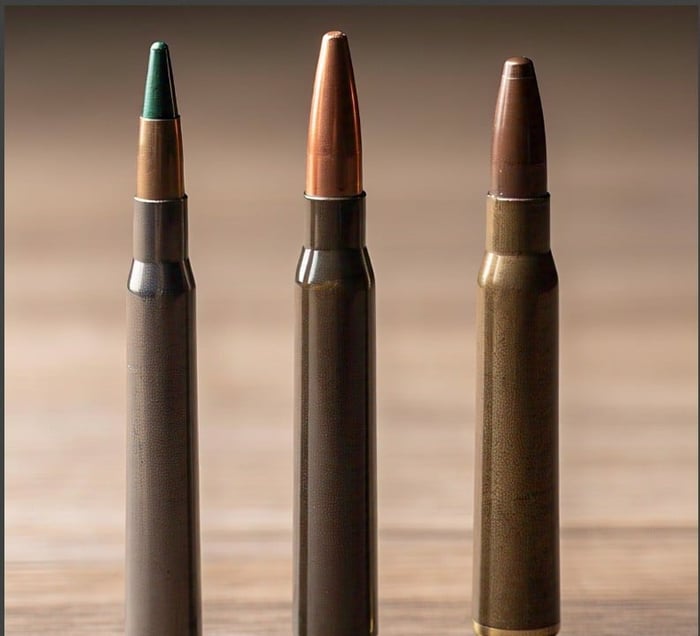When it comes to selecting the ideal rifle cartridge for hunting or long range, the 6.5 Creedmoor vs 243 debate is one that ignites heated discussions among gun enthusiasts. Both cartridges are popular, versatile, and extremely effective, but they appeal to slightly different needs we're going to explore in-depth the 6.5 Creedmoor vs 243 showdown, detailing their histories, ballistic capabilities, use scenarios, and more to guide you in determining which one best suits your shooting preferences.
Whether you are an experienced hunter, a competitive marksman, or an entry-level user wanting to learn about these cartridges, this guide will explain all things in easy-to-grasp terms. So, let's begin!
What is the 6.5 Creedmoor? Understanding the Basics of 6.5 Creedmoor vs 243
The 6.5 Creedmoor is a fairly new cartridge brought to market by Hornady in 2007. It was designed solely for long-range precision shooting and was immediately popular among competitive shooters and hunters. Its streamlined design, high ballistic coefficient, and mild recoil make it a top choice for those who value accuracy down longer ranges.
On the other hand, the .243 Winchester, introduced in 1955, is a classic cartridge known for its versatility. It’s a go-to choice for hunters targeting varmints, predators, and medium-sized game like deer. The 6.5 Creedmoor vs 243 debate often centers on their differences in range, power, and recoil, which we’ll explore in detail.
Both cartridges are fired in bolt-action rifles and some semi-automatic models, but each excels under different circumstances. To appreciate the 6.5 Creedmoor vs 243 comparison entirely, let's examine their development and original intentions.
A Brief History of 6.5 Creedmoor vs 243 Winchester
The Rise of the 6.5 Creedmoor
The 6.5 Creedmoor was conceived as a way of designing a round that would achieve superior long-range performance with little recoil. Hornady's designers sought to design a round that would be competitive in precision rifle competitions as well as be appropriate for hunting. What they produced was a cartridge that harmoniously balances velocity, energy, and accuracy to be the best in the 6.5 Creedmoor vs 243 debate.
Since its release, the 6.5 Creedmoor has been a shooting world darling, with rifles in this caliber being made by such big-name manufacturers as Ruger, Savage, and Remington. Its energy retention at longer ranges has won it over for hunters after elk, mule deer, and even pronghorn.
The Legacy of the.243 Winchester
The .243 Winchester also enjoys a longer heritage, having been introduced more than 50 years prior to the 6.5 Creedmoor. As a necked-down variant of the .308 Winchester, the .243 was conceived as a two-purpose cartridge: useful for varmint shooting with lighter bullets and sufficient to take down medium-sized game with heavier ones. Its adaptability has served to maintain it in the 6.5 Creedmoor vs 243 conversation.
The availability of the.243 Winchester and its past performance make it a hunting-world standard. It's popular with younger or sensitive-to-recoil shooters because its mild kick, a major difference when considering 6.5 Creedmoor vs 243, makes it easy to manage.
Ballistic Performance: 6.5 Creedmoor vs 243 Compared
When comparing 6.5 Creedmoor vs 243, ballistics are the concern at center stage. Here's the breakdown of how these cartridges compare in terms of velocity, energy, trajectory, and recoil.
Velocity and Muzzle Energy
6.5 Creedmoor: Generally, a 6.5 Creedmoor with a 140-grain bullet exits the barrel at approximately 2,700-2,800 feet per second (fps) with muzzle energy of about 2,200-2,400 foot-pounds. Its heavier bullets and streamlined design make it lose energy less at extended ranges, so it's suited for shooting long distances.
.243 Winchester: A .243 shooting a 100-grain bullet has a muzzle velocity of approximately 2,960-3,100 fps and produces approximately 1,800-2,000 foot-pounds of energy. The lighter bullets of the .243 provide it with a flatter trajectory at closer ranges, which is beneficial when hunting varmints.
In 6.5 Creedmoor vs 243, the .243 Creedmoor gains an advantage in terms of energy retention, whereas the .243 Winchester benefits from better velocity with lightweight bullets.
Trajectory and Long-Range Accuracy
The 6.5 Creedmoor is also very famous for its flat shooting and high ballistic coefficient, implying that it resists wind drift and keeps accuracy at ranges over 500 yards. This makes it one of the best options for long-distance target shooting and hunting missions where shots will be over 300 yards.
.243 Winchester, though accurate too, is ideal for less than 300-yard ranges. Its lightweight bullets are more prone to wind drift at long distances, making it an important factor in the 6.5 Creedmoor vs 243 comparison for range enthusiasts.
Recoil Comparison
Recoil is a major concern for most shooters, particularly when weighing 6.5 Creedmoor against 243. The.243 Winchester has less recoil than the 6.5 Creedmoor and is, therefore, a great option for young shooters, recoil-sensitive shooters, or any shooter who prefers a pleasant shooting experience.
The 6.5 Creedmoor, although still mild, has a little more recoil with its heavier bullets and greater energy. Nevertheless, the recoil for both cartridges is mild to most shooters compared to larger calibers such as the.308 Winchester or.30-06 Springfield.
Hunting Applications: 6.5 Creedmoor vs 243 for Game
Both the 6.5 Creedmoor and .243 Winchester are very good hunting cartridges, but they excel in different ways. Let's examine how they do for different types of game.
Varmint and Predator Hunting
For varmint hunting (consider prairie dogs, coyotes, or groundhogs), the.243 Winchester is difficult to beat. Its flat trajectory and high velocity with 55- to 80-grain bullets make it incredibly accurate on small, fast-moving targets. The.243's capacity to reduce pelt damage is another reason it's a favorite among predator hunters.
Conversely, the 6.5 Creedmoor is less typically employed for varmint hunting because it has heavier bullets and costs more per round. Nevertheless, it can be effective for predators such as coyotes at further distances, which makes it a niche application within the 6.5 Creedmoor vs 243 debate.
Medium-Sized Game
For hunting deer, antelope, or comparably sized animals, both cartridges perform well, but the 6.5 Creedmoor is superior for distant shots. Its heavier bullets (120-140 grains) impart more energy and travel deeper, so it is best for larger deer species or beyond 300 yards.
The.243 Winchester, using 90- to 100-grain bullets, is well suited for whitetail deer and pronghorn out to 300 yards. Its lighter recoil and flatter bullet trajectory make it an excellent option for hunters who want to deliver quick follow-up shots.
Larger Game
For bigger game such as elk or moose, the 6.5 Creedmoor is the superior option in the 6.5 Creedmoor vs 243 debate. Its heavier bullets and higher energy retention allow it to make ethical kills on elk at reasonable ranges, as long as shot placement is accurate.
The.243 Winchester is usually found to be underpowered for bigger game such as elk. Although it can get the job done with ideal shot placement, most hunters prefer more powerful cartridges for these species.
Ammunition Availability and Cost: 6.5 Creedmoor vs 243
When deciding between 6.5 Creedmoor vs 243, ammunition availability and cost are practical factors.
6.5 Creedmoor: With its newer design, the 6.5 Creedmoor has gained popular acceptance, and major manufacturers now offer it with products from such companies as Hornady, Federal, and Nosler. Although it is typically more costly than the.243, prices currently range from around $1.50 to $3 per shot, depending upon the company and type of bullet.
.243 Winchester: The.243 is aided by its long history and widespread adoption, and it is one of the cheapest centerfire rifle cartridges. You can get.243 ammunition for as little as $0.80 per round for plain hunting loads, with premium rounds costing between $1.50-$2.
In the 6.5 Creedmoor vs 243 argument, the.243 Winchester is the cheaper option, particularly for high-volume shooters or those reloading for hunting season.
Rifle Availability: 6.5 Creedmoor vs 243 Choices
Both cartridges have a broad range of supported rifles, but their availability is slightly different.
6.5 Creedmoor: Many top rifle manufacturers now have models in 6.5 Creedmoor, from affordable Ruger American to high-end precision rifles such as the Tikka T3x. Its popularity for long-range shooting has resulted in an explosion of aftermarket products, including chassis systems and barrels.
.243 Winchester: The .243 has been used in hundreds of rifles throughout the decades, including old-school models like the Winchester Model 70 and new-school models like the Savage Axis. Its popularity results in plentiful used models being available for purchase, typically lower in price than 6.5 Creedmoor versions.
Comparing 6.5 Creedmoor vs 243, both cartridges provide great rifle options, but the longer history of.243 gives it a competitive edge in the used market.
Reloading: 6.5 Creedmoor vs 243 for Handloaders
For the reloaders, both the 6.5 Creedmoor and.243 Winchester are great options, but they suit different tastes.
6.5 Creedmoor: Reloading the 6.5 Creedmoor is easy, with numerous bullets available in 6.5mm (.264 caliber). Handloaders can try different powders and bullet weights to achieve best performance for long-range shooting or hunting.
.243 Winchester: The.243 is reloaders' favorite because it is versatile. Handloaders can customize loads for varmint hunting, deer hunting, or target shooting with bullet weights from 55 to 105 grains.
In the 6.5 Creedmoor vs 243 reloading debate, both cartridges are easy to work with, but the.243's greater bullet weight range makes it slightly more versatile.
Which cartuus is worthy of you? 6.5 Last Thoughts on Creedmoor VS
The selection between 6.5 creedmoor vs There is a quick re-connectness that your decision is helping:
6.5 Creedmoor if choose:
You give priority to the long distance and the energetic wearing.
You hunt larger game like elk or mule deer at extended ranges.
You’re involved in precision rifle competitions or long-range target shooting.
Choose the .243 Winchester if:
You want a general-purpose cartridge for varmint, predator, and medium game hunting.
You like lesser recoil and lower-cost ammunition.
You shoot mostly at ranges below 300 yards.
Both the 6.5 Creedmoor and .243 Winchester are great cartridges with dedicated fan bases. Learning about their advantages and disadvantages, you can make a well-informed decision that best suits your shooting requirements.
FAQs About 6.5 Creedmoor vs 243
Is the 6.5 Creedmoor more energetic than the .243 Winchester?
Yes, the 6.5 Creedmoor tends to be more energetic, particularly at longer distances, because of its heavier bullet weights. Nevertheless, the .243 Winchester develops greater velocity but with lighter bullet weights and is thus more applicable to varmint hunting.
Can the .243 Winchester be employed for long-range shooting?
Although the.243 Winchester is reliable at middle ranges (up to 300 yards), it's not as good for long-range shooting as the 6.5 Creedmoor because its bullets are lighter and its ballistic coefficient is lower.
Which cartridge is preferable for deer hunting?
Both cartridges are excellent for deer hunting, but the 6.5 Creedmoor is better for longer shots and larger deer species, while the .243 Winchester is ideal for whitetail deer within 300 yards.
By now, you should have a good understanding of the 6.5 Creedmoor vs 243 controversy. Whether you find yourself attracted to the new accuracy of the 6.5 Creedmoor or the long-proven flexibility of the .243 Winchester, each cartridge has its niche in the world of shooting. Happy shooting!





